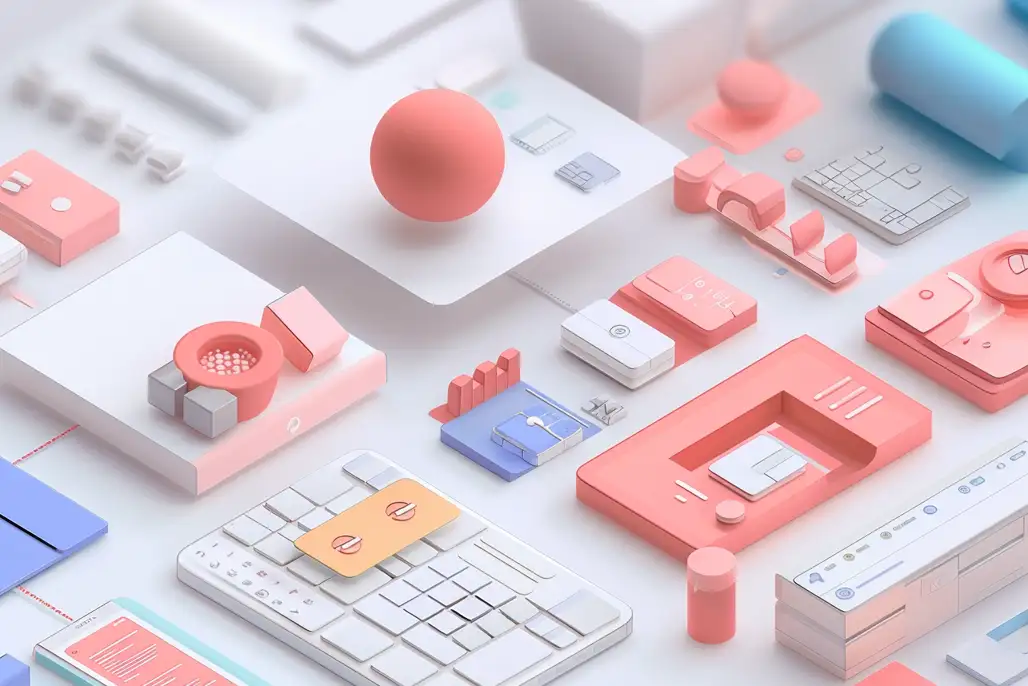Systematic
Without a design system, teams often reinvent the wheel for each new project, leading to duplicated efforts, increased design time, slowed development, and higher costs.
The absence of a centralized system makes implementing updates across different platforms difficult, leading to outdated product versions. Maintaining a consistent brand presence across different devices can be challenging without a design system.
Without it, a product may become disjointed and hard to manage, impacting user experience and development process efficiency.
What is Atomic Design?

Atomic Design is a design system methodology introduced by Brad Frost in 2013. Frost, with a background in Design and development, is a leading influencer in modern web practices. His website, bradfrost.com, serves as a hub for emphasizing adaptability and user-centric experiences in web design.
Atomic Design applies a chemistry-inspired approach to web design. It emphasizes breaking down a design system into its fundamental building blocks, much like atoms in chemistry, breaking down interfaces into fundamental building blocks: atoms, molecules, organisms, templates, and pages, to create a consistent and scalable design system.
The Five Stages of Atomic Design
1. Atoms
Atoms are the most basic building blocks of a design system. They represent the fundamental elements of a web interface, similar to how atoms are the basic units of matter in chemistry. In the context of web design, atoms include basic HTML elements such as labels, inputs, buttons, and other elements that cannot be broken down further without losing their functional purpose.
These atoms serve as the foundational styles for the design system, showcasing the basic styles like font sizes, colours, and spacing. While atoms are simple and abstract on their own, they gain significance when combined with other elements to form more complex structures.
In Atomic Design, atoms are not used in isolation; instead, they are combined to create molecules, which are groups of atoms bonded together to perform a specific function. This modular approach allows for the creation of scalable and maintainable design systems that can adapt to various needs and contexts.
2. Molecules
Examples of molecules includes:
-
Card Components: Made up of an image, text block, and a call-to-action button.
-
Search Forms: Combining a label, input field, and button.
-
Navigation Menus: Grouping of buttons and links for site navigation.
3. Organisms
Organisms are a crucial component that represent a more complex structure within a design system. Within a design system, organisms represent a more complex structure as groups of atoms and molecules work together to form distinct sections of a user interface. Unlike atoms and molecules, which are more abstract and basic, organisms represent concrete, reusable components that designers can easily identify with specific actions or purposes within a design system. A header on a website, for example, can be seen as an organism.
This header could include a logo (atom), a navigation bar (molecule), and a search form (molecule). These components work together to create a cohesive, functional unit that serves a specific role in the interface. Organisms can also include other organisms, allowing for the creation of even more complex structures. Essentially, organisms are the building blocks allowing designers to create more sophisticated and functional user interfaces. They bridge the gap between simple UI components and the final design, enabling the creation of templates and pages that define the overall layout and content structure of a website or application.
4. Templates
Templates are crucial as they are the structural backbone for creating consistent and scalable design systems. Templates are page-level constructs that organize the various components—atoms, molecules, and organisms—into a cohesive layout. They provide a framework that defines the arrangement and interaction of these components without focusing on the final content itself. Templates are essential for maintaining design consistency across different pages and use cases. They help ensure that all design elements work well together, which is important for creating a smooth user experience.
For instance, a template for a product page might include a header organism, a product description organism, and a price molecule, all arranged systematically to form a coherent layout. Using templates, designers and developers can efficiently create new pages by filling in actual content, allowing for flexibility and adaptability in the design process. This approach speeds up the development of new pages and ensures that the Design remains consistent with the overall system, making it easier to update and maintain over time.
5. Pages
Pages are specific instances of templates filled with actual content, such as text, images, and media. They are the most tangible aspect of the design system, showing how all the smaller components—atoms, molecules, organisms, and templates—work in harmony to create a cohesive and functional user interface. This stage is essential for testing the effectiveness and resilience of the design system, ensuring that it holds up well when populated with real-world content.
By focusing on Pages, designers can identify any issues or inconsistencies in the design system and make necessary adjustments to the underlying components. This iterative process helps refine the design system, ensuring it remains flexible and adaptable to various content needs and user interactions.
Benefits of
Atomic Design
-
Consistency: Atomic Design uses a modular approach to ensure consistency and enhance user experience across different project parts, reducing discrepancies.
-
Reusability: Designing components using Atomic Design enables reusing them across multiple projects, saving time and resources. This approach promotes efficiency and empowers teams to focus on innovation rather than starting from scratch each time.
-
Scalability: The methodology’s hierarchical structure makes it easier to scale design systems as projects grow. It allows for the addition of new components without disrupting the existing structure, ensuring that the design system remains flexible and adaptable.
-
Collaboration: Atomic Design fosters a unified language for seamless communication and collaboration between designers and developers. This shared understanding empowers teams to enhance their efficiency and create harmonious design systems.
Applying Atomic Design in Practice
- Identify Atoms: Begin by establishing the fundamental elements of your design system, including buttons, labels, and input fields. These foundational components will form the basis for more intricate design elements.
- Create Molecules: Combine atoms to form simple, reusable UI components. Ensure each molecule serves a specific purpose and can be used across different design parts.
- Develop Organisms: Efficiently assemble molecules into more significant, functional interface sections where organisms represent vital parts of the Design, such as navigation bars or content grids.
- Design Templates: Utilize living organisms to establish page arrangements that delineate the Design’s organization and hierarchy. Templates ought to offer a uniform structure for structuring content.
- Build Pages: Make sure to populate templates with actual content, so that user interfaces are fully developed. Evaluate the design system’s performance by confirming that all elements integrate smoothly with each other.
Implementing Atomic Design with Pattern Lab
In order to implement Atomic Design, Brad Frost and Dave Olsen devised a tool called Pattern Lab. Pattern Lab is a static site generator designed to facilitate the creation and administration of design systems based on the principles of Atomic Design. It enables the development of a library of components that can be easily reused and customized across multiple projects.
Pattern Lab serves as a framework for organizing and documenting design patterns, streamlining the maintenance of consistency and scalability within design systems. It has the capability to support various technologies and can be seamlessly integrated with tools like Sketch, thereby enhancing design workflows.
Conclusion
Atomic Design is a powerful methodology that transforms how we approach interface design. By breaking down complex systems into modular components, it promotes consistency, reusability, and scalability.
This structured approach not only enhances the design process but also improves collaboration between designers and developers. As digital interfaces continue to develop, Atomic Design provides a robust framework for creating thoughtful and effective design systems.






